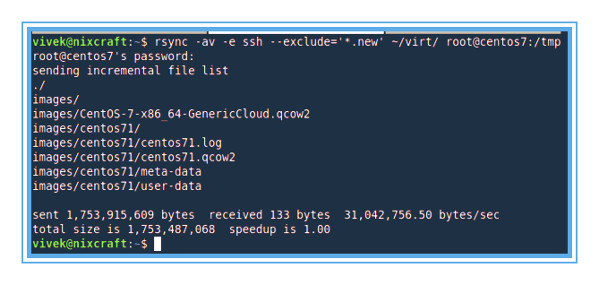SCP usage tips-recursively exclude files

One can use the scp command to securely copy files between network hosts. It uses ssh for data transfer and authentication. Typical syntax is:
scp file1 user@host:/path/to/dest/ scp -r /path/to/source/ user@host:/path/to/dest/
I don't think you can filter or exclude files when using the scp command. However, there is a good workaround to exclude the file and copy it securely using ssh. This page explains how to filter or exclude files when copying a directory recursively using scp.
The syntax is:
rsync av -e ssh --exclude='*.out' /path/to/source/ user@hostB:/path/to/dest/
here:
- -a: Recurse into the directory, i.e. copy all files and subdirectories. Also, turns on archive mode and all other options (equivalent to -rlptgoD)
- -v: Verbose output
- -e ssh: Use ssh as the remote shell so everything is encrypted
- --exclude='*.out': Exclude files matching the pattern, such as *.out or *.c, etc.
In this example, all files are copied recursively from the ~/virt/ directory, but all *.new files are excluded:
$ rsync -av -e ssh --exclude='*.new' ~/virt/ root@centos7:/tmp
Example output:

Scp exclude files but using rsync exclude command
If rsync is not found on the remote server, the rsync command will fail. In this case, try using the following scp command, which uses bash shell pattern matching in the current directory (it does not work with the -r option):
$ ls
Example output:
centos71.log centos71.qcow2 centos71.qcow2.new centos71.v2.qcow2.new meta-data user-data
Copy everything in the current directory except .new:
$ shopt -s extglob $ scp !(*.new) root@centos7:/tmp/
Example output:
centos71.log 100 % 4262 1.3MB/s 00:00 centos71.qcow2 100 % 836MB 32.7MB/s 00: 25 meta-data 100 % 47 18.5KB/s 00:00 user-data 100 % 1543 569.7KB/s 00:00
For more information, see the following man pages:
$ rsync -av -e ssh --exclude='*.new' ~/virt/ root@centos7:/tmp
The above is the detailed content of SCP usage tips-recursively exclude files. For more information, please follow other related articles on the PHP Chinese website!

Hot AI Tools

Undresser.AI Undress
AI-powered app for creating realistic nude photos

AI Clothes Remover
Online AI tool for removing clothes from photos.

Undress AI Tool
Undress images for free

Clothoff.io
AI clothes remover

Video Face Swap
Swap faces in any video effortlessly with our completely free AI face swap tool!

Hot Article

Hot Tools

Notepad++7.3.1
Easy-to-use and free code editor

SublimeText3 Chinese version
Chinese version, very easy to use

Zend Studio 13.0.1
Powerful PHP integrated development environment

Dreamweaver CS6
Visual web development tools

SublimeText3 Mac version
God-level code editing software (SublimeText3)

Hot Topics
 1659
1659
 14
14
 1416
1416
 52
52
 1310
1310
 25
25
 1258
1258
 29
29
 1232
1232
 24
24
 Linux Architecture: Unveiling the 5 Basic Components
Apr 20, 2025 am 12:04 AM
Linux Architecture: Unveiling the 5 Basic Components
Apr 20, 2025 am 12:04 AM
The five basic components of the Linux system are: 1. Kernel, 2. System library, 3. System utilities, 4. Graphical user interface, 5. Applications. The kernel manages hardware resources, the system library provides precompiled functions, system utilities are used for system management, the GUI provides visual interaction, and applications use these components to implement functions.
 How to check the warehouse address of git
Apr 17, 2025 pm 01:54 PM
How to check the warehouse address of git
Apr 17, 2025 pm 01:54 PM
To view the Git repository address, perform the following steps: 1. Open the command line and navigate to the repository directory; 2. Run the "git remote -v" command; 3. View the repository name in the output and its corresponding address.
 vscode Previous Next Shortcut Key
Apr 15, 2025 pm 10:51 PM
vscode Previous Next Shortcut Key
Apr 15, 2025 pm 10:51 PM
VS Code One-step/Next step shortcut key usage: One-step (backward): Windows/Linux: Ctrl ←; macOS: Cmd ←Next step (forward): Windows/Linux: Ctrl →; macOS: Cmd →
 How to run sublime after writing the code
Apr 16, 2025 am 08:51 AM
How to run sublime after writing the code
Apr 16, 2025 am 08:51 AM
There are six ways to run code in Sublime: through hotkeys, menus, build systems, command lines, set default build systems, and custom build commands, and run individual files/projects by right-clicking on projects/files. The build system availability depends on the installation of Sublime Text.
 How to run java code in notepad
Apr 16, 2025 pm 07:39 PM
How to run java code in notepad
Apr 16, 2025 pm 07:39 PM
Although Notepad cannot run Java code directly, it can be achieved by using other tools: using the command line compiler (javac) to generate a bytecode file (filename.class). Use the Java interpreter (java) to interpret bytecode, execute the code, and output the result.
 What is the main purpose of Linux?
Apr 16, 2025 am 12:19 AM
What is the main purpose of Linux?
Apr 16, 2025 am 12:19 AM
The main uses of Linux include: 1. Server operating system, 2. Embedded system, 3. Desktop operating system, 4. Development and testing environment. Linux excels in these areas, providing stability, security and efficient development tools.
 laravel installation code
Apr 18, 2025 pm 12:30 PM
laravel installation code
Apr 18, 2025 pm 12:30 PM
To install Laravel, follow these steps in sequence: Install Composer (for macOS/Linux and Windows) Install Laravel Installer Create a new project Start Service Access Application (URL: http://127.0.0.1:8000) Set up the database connection (if required)
 How to use VSCode
Apr 15, 2025 pm 11:21 PM
How to use VSCode
Apr 15, 2025 pm 11:21 PM
Visual Studio Code (VSCode) is a cross-platform, open source and free code editor developed by Microsoft. It is known for its lightweight, scalability and support for a wide range of programming languages. To install VSCode, please visit the official website to download and run the installer. When using VSCode, you can create new projects, edit code, debug code, navigate projects, expand VSCode, and manage settings. VSCode is available for Windows, macOS, and Linux, supports multiple programming languages and provides various extensions through Marketplace. Its advantages include lightweight, scalability, extensive language support, rich features and version




